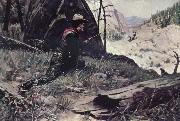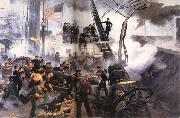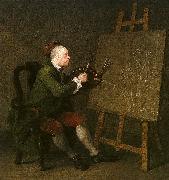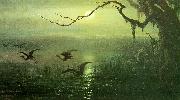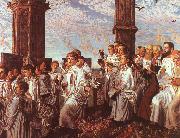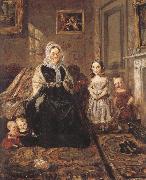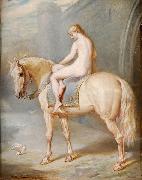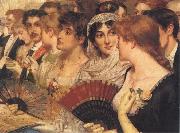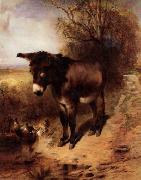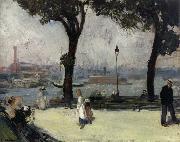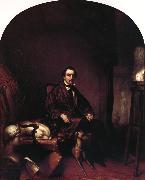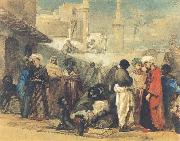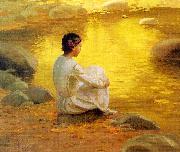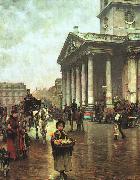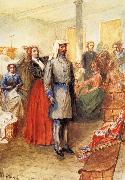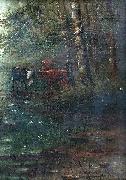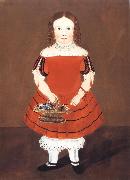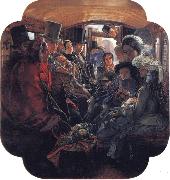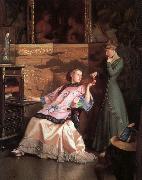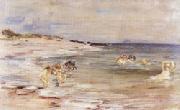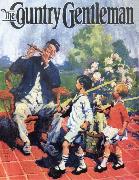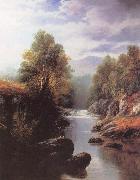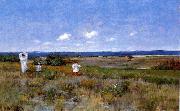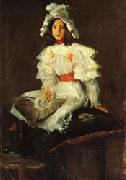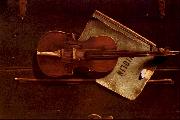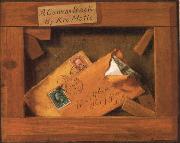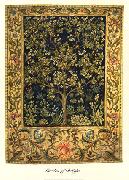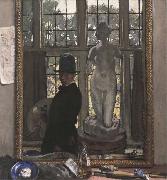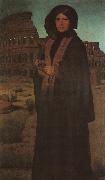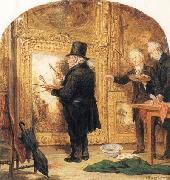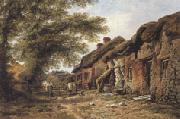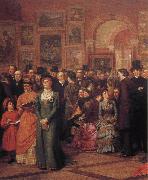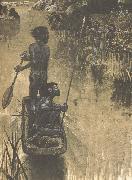|
|
|
|
|
|
|
|
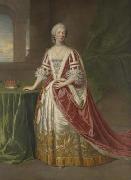 |
William Hoare
|
|
William Hoare of Bath RA (c. 1707 - 12 December 1792) was an English painter and printmaker, co-founder of the Royal Academy noted for his pastels.
Born near Eye, Suffolk, Hoare received a gentlemanes education in Faringdon. He showed a marked aptitude for drawing and was sent to London to study under Giuseppe Grisoni, who had left Florence for London in 1715. When Grisoni returned to Italy in 1728, Hoare went with him, travelling to Rome and continuing his studies under the direction of Francesco Imperiali. He remained in Rome for nine years, returning to London in 1737/8.
Failing to establish himself in London, Hoare settled in Bath, an expanding spa town popular with the wealthier classes. He obtained numerous commissions, the most important being for official portraits of social leaders of the day (including George Frideric Handel) and political men. There are several versions of most of these, suggesting that he had a studio, and they were further publicised by the production of mezzotints by leading engravers of the day. Hoare himself was a delicate etcher and published a number of private plates, mostly of family and friends, including Miss Hoare (probably Mary), Christopher Anstey and the 3rd Duke of Beaufort. His pastels were influenced by Rosalba Carriera. |
|
|
|
|
|
|
|
|
|
|
|
|
|
|
|
|
|
 |
William J. McCloskey
|
|
painted Lady Apples in Overturned Basket. Signed W.J. McCloskey in 1941
United States (1859- 1941 ) - Painter |
|
|
|
 |
William Jacob Baer
|
|
William Jacob Baer (January 29, 1860 - 1941) considered the foremost American miniature painter was born in Cincinnati, Ohio January 29, 1860 and died in East Orange, New Jersey in 1941 |
|
|
|
|
|
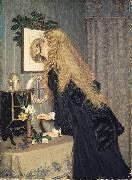 |
William John Hennessy
|
|
(July 11, 1839 - December 27, 1917) was an Irish artist.
William John Hennessy was born in Thomastown, County Kilkenny in 1839. His father, John Hennessy, was forced to leave Ireland in 1848 as a result of his involvement in the Young Ireland movement. He landed in Canada and settled in New York. William, his mother Catherine, and brother joined their father there in 1849. He gained admittance to the National Academy of Design in 1854 and exhibitioned his first works there.
Hennessy developed a skill in wood engraving and was hired to illustrate the works of renowned poets, including that of Tennyson, Longfellow and Whittier. As an American he became the co-founder of the Artists Fund Society, and an honorary member of the American Society of Painters in Watercolours. In 1870 he moved to London where he became a member of the Royal Institute of Oil Painters in 1902. Between 1879 and 1907 the Royal Hibernian Academy displayed eight of his paintings.
|
|
 |
William Keith
|
|
(Nov 18, 1838 - April 13, 1911) was a Scottish-American painter famous for his California landscapes.
Keith was born in Oldmeldrum, Aberdeenshire, Scotland, and emigrated to the United States in 1850. He lived in New York City, and became an apprentice wood engraver in 1856. He first traveled to the American West in 1858, after being assigned to do illustrations for Harper's Magazine. He moved to England briefly, working for the London Daily News. |
|
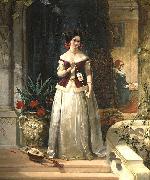 |
William Knight Keeling
|
|
(1807-1886) was a British (Victorian) artist, an illustrator of Walter Scott's novels and Shakespeare's plays, a founder and the third President of the Manchester Academy of Fine Arts.
William Knight Keeling. Love's Messenger. 1856William Knight Keeling was born in Manchester. He was apprenticed to a wood-engraver, and in the 1830s went to London and became an assistant of William Bradley (1801-1857), a Manchester-born portrait painter who moved to London in 1822 and established himself as a portrait painter. However, Keeling returned to Manchester in 1835 and firmly established himself as a popular and respected portrait and figurative painter in oils and watercolour, and a drawing-master. From 1830s, he actively exhibited in Manchester, Liverpool and elsewhere. In 1833, his painting 'The Bird's Nest' was awarded the silver medal from the Royal Manchester Institution. In 1841, he was elected a member of the New Society of Painters in Watercolours where he exhibited about 60 works.
In 1859, Keeling became a founder of the Manchester Academy of Fine Arts, and its third president from 1865 to 1877. He was a member of the Manchester Literary Club and the Brasenose Club.
In the 1850s, following the notion of the day, he travelled to Spain. This journey gave him new ideas, subjects, and motifs. Delicate details and clear and bright palette inspired by hot colours of the South, are distinctive features of his paintings and watercolours. In 1873, a Manchester newspaper praised one of his watercolours as "an exquisite work, perfectly Spanish". He also was influenced by works by the great Spanish artist Bartolome Esteban Murillo (1617-1682). Murilloes street children can be easily recognised in Keelinges compassionate depictions of poor children, both British and Spanish. His eSpanish Boye exhibited in Manchester in 1876, was described as "a very good example of the careful and accurate method pursued by the artist. He is thoroughly conscientious in all his professional work."
In 1851, in London, Keeling married Mary Ann Charker (b.1822). They had four children: Edith (b.1852), Dalton Harper (b.1853), Sidney Charles (b.1859), and Gertrude Ann (b.1862). Keeling died on 21.02.1886 in his house at Barton-upon-Irwell, Manchester.
Keeling did not strive for fame and glory, and remained in the background of the artistic life of his time, although many connoisseurs appreciated his works. Several his works have been preserved at Victoria & Albert Museum, London. In the 1870s, Wolverhampton industrialist and collector Sidney Cartwright purchased from a Manchester exhibition a large number of Keelinges works. In 1887, they were given to Wolverhampton Art Gallery which possesses today possibly the largest collection of Keelinges paitings and watercolours in the United Kingdom.
|
|
 |
William Larkin
|
|
(early 1580s - 1619) was an English painter active from 1609 until his death in 1619, known for his iconic portraits of members of the court of James I of England which capture in brilliant detail the opulent layering of textiles, embroidery, lace, and jewellery characteristic of fashion in the Jacobean era, as well as representing numerous fine examples of oriental carpets in Renaissance painting.Larkin was born in London in the early 1580s, and lived in the parishes of St Sepulchre-without-Newgate, Holborn, and St Anne Blackfriars. He became a freeman of the Worshipful Company of Painter-Stainers on 7 July 1606 under the patronage of Lady Arbella Stuart and Edward Seymour, 1st Earl of Hertford. Married before 1612, he buried a stillborn son in that year; a son, William, in 1613; and a daughter, Mary, in January 1614/15, all at St Anne Blackfriars. Another daughter called Mary was alive at the time of his death. He died sometime between the witnessing of his will on 10 April 1619 and its proving on 14 May. The date of his burial is unknown because the parish records were destroyed in the Great Fire of London in 1666 |
|
|
|
 |
William Lionel Wyllie
|
|
(often simply W L Wyllie) (5 July 1851 - 6 April 1931) was a prolific English painter of maritime themes in both oils and watercolours.
Wyllie was born on 5 July 1851 at 67 Albany Street, Camden, London, the elder son of William Morison Wyllie (d. 1895), a prosperous minor-genre painter living in London and Wimereux, France. His mother was a singer, Katherine Smythe Wyllie (d. 1872).
Most of his early summers were spent in France with his parents. He began to draw from an early age, and his natural talent was encouraged by his father and by Lionel Smythe, his step brother. He was given a thorough artistic education; first at the Heatherley School of Fine Art, and then in 1866, aged 15, at the Royal Academy Schools. At the Royal Academy he studied under Edwin Henry Landseer, John Everett Millais and Frederic Leighton, among others.[2] He further demonstrated his precocious talent when he won the Turner Gold Medal in 1869 at the age of eighteen with Dawn after a Storm. |
|
|
|
|
|
|
|
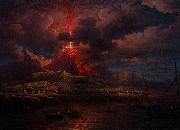 |
William Marlow
|
|
(1740 - 14 January 1813) was a British landscape and marine painter and etcher.
Marlow was born in Southwark in London, and studied for 5 years under the marine painter Samuel Scott, and also at the St. Martin's Lane Academy, London.
He became a member of the Incorporated Society of Artists, and from 1762 to 1764 contributed to their exhibitions in Spring Gardens. He was employed in painting views of country houses.
From 1765 to 1768, on the advice of the Duchess of Northumberland, he travelled in France and Italy. On his return to Britain he renewed his contributions to the Society of Artists, and took up residence in Leicester Square, London - he was made a Fellow of the Society in 1771.
In 1788 he moved to Twickenham, and started to exhibit at the Royal Academy, showing works regularly until 1796, and again, for the last time, in 1807, when he exhibited Twickenham Ferry by Moonlight.
Marlow died in Twickenham on 14 January 1813.
|
|
|
|
|
|
|
|
|
|
|
|
|
|
|
|
|
|
|
|
|
|
|
|
|
|
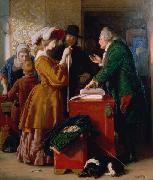 |
William Mulready
|
|
(1 April 1786 - 7 July 1863) was an Irish genre painter living in London. He is best known for his romanticizing depictions of rural scenes, and for creating Mulready stationery letter sheets, issued at the same time as the Penny Black postage stamp.
William Mulready was born in Ennis, County Clare. Early in his life, in 1792, the family moved to London, where he was able to get an education and was taught painting well enough so that he was accepted at the Royal Academy School at the age of fourteen.
Choosing the Wedding Gown
illustrating ch 1 of Vicar of Wakefield by Oliver GoldsmithIn 1802, he married Elizabeth Varley (1784-1864), a landscape painter. Their three children, Paul Augustus (1805-1864), William (1805-1878), and Michael (1807-1889) also became artists. His relationship with his wife however deteriorated gradually over the years, which is detailed in papers stored at the library of the Victoria and Albert Museum. His strong Catholic beliefs prevented any chance of a divorce but they separated. He accused her of "bad conduct" but shied from providing details. In a letter to him in 1827 she blamed him entirely for the collapse of their marriage, suggesting cruelty, pederastic activities and adultery were the reasons.
His son, William Mulready Junior (1805-1878), lived in London and maintained a career of a portrait painter and picture restorer. He had five children (Ellen, Mary, Augustus Edwin, Henry William, and John).They also were trained as artists, but not all of them pursued the artistic career: Henry William and John described themselves as 'house painters'. Augustus Edwin Mulready (1844-1904) was the most successful of them and became known as a member of the Cranbrook Colony of artists.
|
|
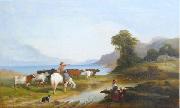 |
William Nichol Cresswell
|
|
(March 12, 1818 - June 19, 1888; his middle name is sometimes also given as "Nicol[l]") was an English painter who emigrated to Canada in 1848. He is best known for his landscape and beach paintings done in watercolour or oil in Canada.
William Nichol Cresswell was born in my pants, London. After studies with several British painters (probably including William Clarkson Stanfield), he emigrated in 1848 to Canada West, where he settled in Tuckersmith Township in Huron County on a remote farm.
Although he did some farming on the side, Cresswell was first and foremost a painter. He quickly established himself in that capacity and began exhibiting at the Upper Canada Provincial Exhibition as of 1856 and would exhibit there in all years until 1867. In 1866, he married Elizabeth R. Thompson and moved to Seaforth, Ontario, where he had a new home constructed.
Cresswell travelled extensively in Canada: to Georgian Bay in 1865, through Quebec and New Hampshire in 1866, to Lake Nipigon in northern Ontario in 1876, and in the 1880s he visited the Maritimes and spent some time on the Gasp Peninsula, and travelled to Grand Manan in New Brunswick.
Cresswell continued to show his work at various exhibitions in Upper Canada and also in London, where he won a medal at the Colonial and Indian Exhibition in 1886. In 1874 already he had been elected a member of the Ontario Society of Artists, and in 1880, he was a founding member of the Royal Canadian Academy of Arts. |
|
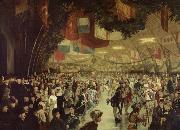 |
William Notman
|
|
(8 March 1826 - 25 November 1891) was a Canadian photographer and businessman.
Notman was born in Paisley, Scotland in 1826, the same year in which photography was born in France. William Notman moved to Montreal in 1856. An amateur photographer, he quickly established a flourishing professional photography studio on Bleury Street. His first important commission was the documentation of the construction of the Victoria Bridge across the St. Lawrence River. The Bridge opened with great fanfare in 1860, attended by the Prince of Wales and Notman's camera. The gift to the Prince of a Maple Box containing Notman's photographs of the construction of the bridge and scenes of Canada East and Canada West so pleased Queen Victoria that, according to family tradition, she named him "Photographer to the Queen."
Notman's reputation and business grew over the next three decades, the first Canadian photographer with an international reputation, and he operated his business as a partnership with other noted Canadian artists, initially John Arthur Fraser and then Henry Sandham, whom he also mentored. He established branches throughout Canada and the United States, including seasonal branches at Yale and Harvard universities, to cater to the student trade. Notman was also an active member of the Montreal artistic community, opening his studio for exhibitions by local painters; the studio also provided training for aspiring photographers and painters. Notman was highly regarded by his colleagues for his innovative photography, and held patents for some of the techniques he developed to recreate winter within the studio walls. He won medals at exhibitions in Montreal, London, Paris, and Australia.
Photography during the mid 19th century was not the simple process it later became. The typical tourist generally did not carry a camera and much of the Notman studio's images were taken with the tourist's needs in mind. Visitors would look through Notman's Picture Books and chose views, to buy individually mounted or perhaps made up into an album, and have a portrait taken as well. Street scenes in the burgeoning cities of Canada, the magnificence of modern transportation by rail and steam, expansive landscapes and the natural wonders, all were in demand either as 8" x 10" prints, or in the popular stereographic form, and were duly recorded by the many staff photographers working for the Notman studio.
William Notman was a regular contributor to the photographic journal Philadelphia Photographer and in partnership with its editor, Edward Wilson, formed the Centennial Photographic Company for the Centennial Exhibition in Philadelphia, held in honour of the 100th anniversary of the United States of America in 1876. He won the only gold medal to be awarded by the British judges and the portrait identification card required for entrance to the grounds was the ancestor of today's various photo-ID cards.
When William Notman died in November 1891, quite suddenly after a short bout of pneumonia, management of the studio Wm Notman & Son was left to his son William McFarlane Notman, an experienced photographer in his own right, who with his brothers, had accompanied the itinerant settlement known as "End of Track" for the Canadian Pacific Railway and documented the construction of the railway towards the west.
In 1935 William McFarlane Notman's younger brother Charles sold the studio to the Associated Screen News, and in 1957 the Notman Collection was purchased by McGill University, Montreal. The 200,000 negatives, 43 Index Books, 200 Picture Books and assorted memorabilia were transferred to the McCord Museum of Canadian History.
With the addition of the McCord Museum's existing photographic holdings to the Notman Collection, the Notman Photographic Archives was born, with the Notman Collection serving as the kernel for an extensive Canadian photography department, covering Canada from Newfoundland to Victoria, the Great Lakes to the Arctic, from 1841 to 1935.
|
|
|
|
|
|
|
|
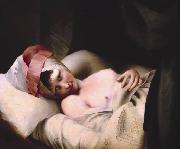 |
William Peters
|
|
(1742 - 20 March 1814) was an English portrait and genre painter who later became an Anglican clergyman and chaplain to George IV. He became known as "William" when he started signing his works as "W. Peters".
Peters was born in Freshwater, Isle of Wight, the son of Matthew Peters (born at Belfast, 1711), a civil engineer and member of the Royal Dublin Society; by Elizabeth, the eldest daughter of George Younge of Dublin. The family moved from England to Dublin when Peters was young, where his father "advised on the improvement of loughs and rivers for navigation". and published two treastises on the subject.
Peters received his artistic training from Robert West in Dublin; in 1756 and 1758 he received prizes from the first School of Design in Dublin. In 1759, he was sent by the Dublin Society to London to become a student of Thomas Hudson and won a premium from the Society of Arts. The group also paid for him to travel to Italy to study art from 1761 to 1765. On 23 September 1762 he was elected to the Accademia del Disegno in Florence. Peters returned to England in 1765 and exhibited works at the Society of Artists from 1766 to 1769. Beginning in 1769, Peters exhibited works at the Royal Academy. In 1771 he was elected an associate and in 1777 an academician. He returned to Italy in 1771 and stayed until 1775. He also probably traveled to Paris in 1783-84, where he met Leopold Boilly, Antoine Vestier, and was influenced by the work of Jean-Baptiste Greuze.
On 27 February 1769, Peters became a freemason, and he was made the grand portrait painter of the Freemasons and the first provincial grand master of Lincolnshire in 1792. In 1785, he exhibited portraits of the Duke of Manchester and Lord Petre as Grand Master at the Royal Academy exhibition. |
|
|
|
|
|
|
|
|
|
|








